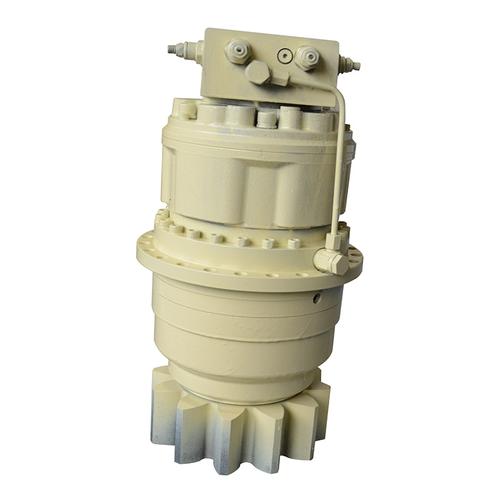Hydraulic motor It is a device that converts liquid pressure energy into mechanical kinetic energy. The output torque and speed ratio are Hydraulic transmission Implementation components of the system.
The basic principle of motor and pump is crossed, but there are some differences in structure due to different main purposes: the motor specifies positive and reverse rotation, and its structure is symmetrical; In order to better ensure the self-priming characteristics of the pump, some countermeasures have been adopted in the structure.
Motor classification:
Ns > 500r/min is fast hydraulic motor: gear motor, leaf motor, radial piston pump motor;
NS<500r/min hydraulic motor at low speed: axial piston pump motor (single effect crankshaft axial piston pump motor, multiple effect internal crankshaft figure axial piston pump motor)
1. Determination of pump and hydraulic motor air displacement
Whether it is closed system software or open system software, whether it is qualitative analysis of hydraulic motor or self Variable hydraulic motor The selection of hydraulic motor air displacement is generally based on the requirements of large load torque during balanced operation or starting torque when the working conditions are extreme.
Whether it is the closed system software or the open system software, whether it is the variable plunger pump or the variable pump, the large displacement of the pump is determined by the larger driving speed when the diesel engine is rated current transmission ratio and the hydraulic motor is at the minimum displacement.
2. Why use independent variable hydraulic motor
Although the turn off system software uses the qualitative analysis of hydraulic motors with small specifications, low cost and high efficiency as far as possible, the moral management of the hydraulic transmission system software makes decisions. In some cases, the output transmission ratio obtained only by adjusting the input end (diesel engine+variable displacement pump) is limited by high efficiency, cost and other factors. Therefore, the output end of some mechanical equipment must be adjusted in addition. Generally, the output torque of system software is sufficient, and the output end is adjusted a lot to expand the range of output transmission ratio in the high efficiency area.
3. What are the output adjustment modes and their characteristics
The important adjustment methods at the output end include changing the exhaust volume of the hydraulic motor, changing the transmission ratio of the rear industrial equipment gearbox, and adjusting the number of hydraulic motors on the network. The following are explained respectively.
The machine equipment of the static four column hydraulic machine controller is important to match the diesel engine. The available transmission ratio of the diesel engine is about 2~4 (for example, the transmission ratio ranges from 800 to 3000). The professional ability of pitch change near the center of the circle in high-power operation is only 1.15~1.3. Therefore, the ratio of available variable pitch of diesel engine is an important factor to damage the transmission ratio coverage of walking industrial equipment.
In the way of variable displacement pump+qualitative analysis of hydraulic motor, the displacement of variable displacement pump varies from about 25% to 100%. After matching with the diesel engine, the total shift ratio is about 8~16, and the total shift ratio is about 4~6. This type of mode is more suitable for mechanical equipment with small walking speed (such as less than 25km/h, 25/16=1.56km/h=0.43m/s, most of which can maintain low gear walking), small torque change of traction rope (such as torque change of traction rope less than 5~10 times), and small walking power, such as cement ground electric forklift, load change to small forklift, small roller, etc.
1) Variable displacement pump+variable displacement hydraulic motor
The air displacement of the independent variable hydraulic motor is about 40%~100%, so the total gear ratio is about 20~40, and the total pitch ratio is about 10~15. The higher driving speed can cover about 40Km/h (40/40=1Km/h=0.28m/s, most of which can maintain low-speed running). The advantages are as follows:
1.1) Expand the high efficiency area of the hydrostatic brake system
When mechanical equipment with a very large distance between speed and air transportation speed is in common operation, if high-power qualitative analysis hydraulic motor is selected (load management decision), the flow must be relatively large at high speed load, and the pump exhaust volume must be very large, but at this time, the system software pressure is relatively low, so the pipeline pressure harm market share is relatively high, The efficiency of the system software deteriorates during operation. When the low speed gear has a large torque, the displacement of the pump must be reduced, and the volume and efficiency are not high. Therefore, the independent variable hydraulic motor can be selected to solve the above contradictions and difficulties. At this time, the large displacement of the hydraulic motor can be determined according to the large load in the low speed gear large torque load, while the displacement of the pump can be determined according to the displacement of the hydraulic motor at the high speed load. The large displacement of the hydraulic motor remains unchanged, but the large displacement of the pump is reduced, the occupancy is reduced, and the displacement ratio of the hydraulic motor is very low. After the use of the independent variable hydraulic motor, the output envelope of the machine equipment of the static four column hydraulic press controller is expanded to the high speed area (as shown in the figure below), expanding the high efficiency area of the brake system of the hydrostatic press. Although the independent variable hydraulic motor is used, the air displacement of the independent variable hydraulic motor is smaller, the efficiency of the hydraulic motor is lower, and the cost of the independent variable hydraulic motor is higher. But at this time, the advantages of the independent variable hydraulic motor outweigh the disadvantages. Therefore, it is suitable for sites with very large power, large torque change and very large speed change.


![]()

